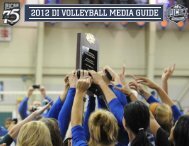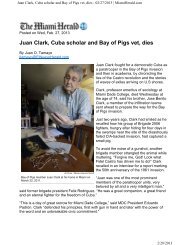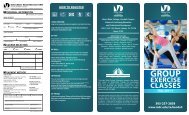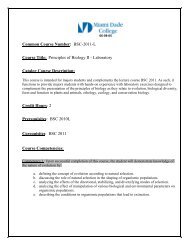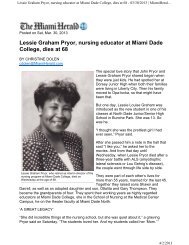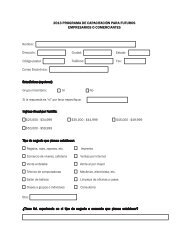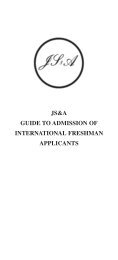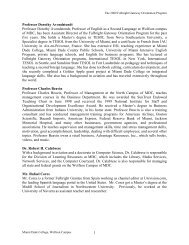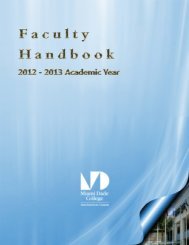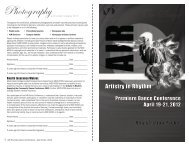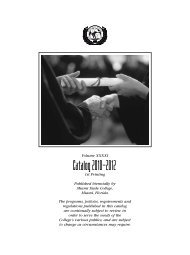Wolfson Campus Student Safety Contract-Biology Laboratory
Wolfson Campus Student Safety Contract-Biology Laboratory
Wolfson Campus Student Safety Contract-Biology Laboratory
You also want an ePaper? Increase the reach of your titles
YUMPU automatically turns print PDFs into web optimized ePapers that Google loves.
<strong>Wolfson</strong> <strong>Campus</strong><br />
Natural Science Department<br />
<strong>Biology</strong> <strong>Laboratory</strong><br />
<strong>Student</strong> <strong>Safety</strong> <strong>Contract</strong><br />
July 2000
<strong>Wolfson</strong> <strong>Campus</strong><br />
<strong>Student</strong> <strong>Safety</strong> <strong>Contract</strong>-<strong>Biology</strong> <strong>Laboratory</strong><br />
Purpose<br />
The <strong>Biology</strong> laboratory is a hands-on learning environment. You will be doing<br />
many laboratory activities which require the use of biohazardous materials<br />
and hazardous chemicals. <strong>Safety</strong> in the laboratory is the #1 priority for<br />
students and instructors. To ensure a safe <strong>Biology</strong> laboratory, a list of rules<br />
has been developed and provided to you in this student safety contract.<br />
These rules must be followed at all times. Two copies of the safety contract<br />
student agreement are provided. One copy must be signed by you before you<br />
can participate in the laboratory. The second copy is to be kept with your<br />
safety contract and lab notes as a constant reminder of the safety rules.<br />
General Guidelines<br />
1. Conduct yourself in a responsible manner at all times in the laboratory.<br />
2. Follow all written and verbal instructions carefully. If you do not<br />
understand a direction or part of a procedure, ask the instructor before<br />
proceeding.<br />
3. When first entering a <strong>Biology</strong> laboratory, do not touch any equipment,<br />
chemicals, or other materials until you are instructed to do so.<br />
4. Do not eat food, drink beverages, or chew gum in the laboratory. Do not<br />
use laboratory glassware as containers for food or beverages.<br />
5. Perform only those experiments authorized by the instructor. Never do<br />
anything in the laboratory that is not called for in the laboratory<br />
procedures or by your instructor. Carefully follow all instructions, both<br />
written and oral. Unauthorized experiments are prohibited.<br />
6. Be prepared for your work in the laboratory. Read all procedures
thoroughly before entering the laboratory. Never fool around in the<br />
laboratory. Horseplay, practical jokes, and pranks are dangerous and<br />
prohibited.<br />
7. Observe good housekeeping practices. Work areas should be kept clean<br />
and tidy at all times. Table tops, fume hoods, lab chairs and sinks should<br />
be cleaned at the end of lab class. Lab material, lab chairs and equipment<br />
should be returned to their proper storage location). Bring only your<br />
laboratory instructions, worksheets, and/or reports to the work area.<br />
Other materials (books, purses, backpacks, etc.) should be stored in a<br />
safe place.<br />
8. Keep aisles clear. Push your chair under the desk when not in use.<br />
9. Know the locations and operating procedures of all safety equipment<br />
including the first aid kit, eyewash station, safety shower, fire<br />
extinguisher. Know where the fire alarm and the exits are located.<br />
10. Always work in a well-ventilated area. Use the fume hood when working<br />
with volatile substances or poisonous vapors. Never place your head into<br />
the fume hood. Use the Biohood when working with biohazardous<br />
materials.<br />
11. Be alert and proceed with caution at all times in the laboratory. Notify<br />
the instructor immediately of any unsafe conditions you observe.<br />
12. Dispose of all chemical waste properly. Never mix chemicals in sink<br />
drains. Sinks are to be used only for water and those solutions<br />
designated by the instructor. Solid chemicals, metals, matches, filter<br />
paper, and all other insoluble materials are to be disposed of in the<br />
proper waste containers, not in the sink. Check the label of all waste<br />
containers twice before adding your chemical waste to the container.<br />
13. Labels and equipment instructions must be read carefully before use.<br />
Set up and use the prescribed apparatus as directed in the laboratory<br />
instructions or by your instructor.<br />
14. Keep hands away from face, eyes, mouth and body while using chemicals<br />
biohazardous materials or preserved specimens. Wash your hands with<br />
soap and water after performing all experiments. Clean (with detergent),
inse, and wipe dry all work surfaces (including the sink) and apparatus<br />
at the end of the experiment. Return all equipment clean and in working<br />
order to the proper storage area.<br />
15. Experiments must be personally monitored at all times. You will be<br />
assigned a laboratory station at which to work. Do not wander around<br />
the room, distract other students, or interfere with the laboratory<br />
experiments of others.<br />
16. Know what to do if there is a fire drill during a laboratory period;<br />
containers must be closed, gas valves turned off, fume hoods turned<br />
off, and any electrical equipment turned off.<br />
17. When using knives and other sharp instruments, always carry with tips<br />
and points pointing down and away. Always cut away from your body.<br />
Never try to catch falling sharp instruments. Grasp sharp instruments<br />
only by the handles.<br />
Clothing<br />
18. Dress properly during a laboratory activity. Wear protective laboratory<br />
clothing when necessary. Long hair, dangling jewelry, and loose or baggy<br />
clothing are a hazard in the laboratory. Long hair must be tied back and<br />
dangling jewelry and loose or baggy clothing must be secured. Shoes<br />
must completely cover the foot. No sandals allowed.<br />
19. Gloves must be worn for all procedures that might involve direct skin<br />
contact with toxins, blood, infectious materials, or infected animals.<br />
Rings or hand jewelry which would interfere with glove functioning should<br />
be removed before gloving. Gloves should be removed carefully and<br />
decontaminated with other laboratory wastes before disposal. Reusable<br />
gloves (e.g. insulated, chemical resistant, etc.) may be used only where<br />
necessary and must be appropriately decontaminated.<br />
Accidents and Injuries<br />
20. Report any accident (spill, breakage, contamination, etc.) or injury (cut,<br />
burn, etc.) to the instructor immediately, no matter how trivial it may<br />
appear.
21. If you or your lab partner are hurt, immediately get the instructor's<br />
attention.<br />
22. If a chemical should splash in your eye(s) or on your skin, immediately<br />
flush with running water from the eyewash station or safety shower for<br />
at least 20 minutes. Notify the instructor immediately.<br />
23. When mercury thermometers are broken, mercury must not be touched.<br />
Notify the instructor immediately.<br />
Handling Chemicals<br />
24. All chemicals in the laboratory are to be considered dangerous. Do not<br />
touch, taste, or smell any chemicals unless specifically instructed to do<br />
so. The proper technique for smelling chemical fumes will be<br />
demonstrated to you.<br />
25. Check the label on chemical bottles twice before removing any of the<br />
contents. Take only as much chemical as you need.<br />
26. Never return unused chemicals to their original containers.<br />
27. Never use mouth suction to fill a pipet. Use a rubber bulb or pipet pump.<br />
28. When transferring reagents from one container to another, hold the<br />
containers away from your body.<br />
29. Acids must be handled with extreme care. You will be shown the proper<br />
method for diluting strong acids. Always add acid to water, swirl or stir<br />
the solution and be careful of the heat produced, particularly with<br />
sulfuric acid.<br />
30. Handle flammable hazardous liquids over a pan to contain spills. Never<br />
dispense flammable liquids anywhere near an open flame or source of<br />
heat.<br />
31. Never remove chemicals or other materials from the laboratory area.<br />
32. Take great care when transferring acids and other chemicals from one<br />
part of the laboratory to another. Hold them securely and walk
carefully.<br />
33. Hands must be washed after gloves are removed, before leaving the<br />
laboratory, and at any time after handling materials known or<br />
suspected to be contaminated.<br />
34. Work surfaces must be cleaned and decontaminated with a suitable<br />
disinfectant at the end of the day and after any spill of potentially<br />
dangerous material. Loose or cracked work surfaces must be replaced<br />
or repaired.<br />
35. All technical procedures must be performed in a manner that<br />
minimizes the creation of aerosols.<br />
36. All contaminated or infectious liquid or solid materials must be<br />
decontaminated before disposal or reuse. Contaminated materials that<br />
are to be autoclaved or incinerated at a site away from the laboratory<br />
must first have the outside of the container disinfected chemically or<br />
be double-bagged.<br />
Handling Glassware and Equipment<br />
37. The proper care and operation of lab equipment (balances protected by<br />
weighing paper, balances shutdown at the end of class, computers<br />
shutdown at the end of class, keyboards, mice and monitors<br />
returned to storage position/location) should be followed.<br />
38. <strong>Student</strong>s should perform their experiments at a safe distance from<br />
laboratory computers (to prevent spills and/or reactions from<br />
damaging the machines).<br />
39. Carry glass tubing, especially long pieces, in a vertical position to<br />
minimize the likelihood of breakage and injury.<br />
40. Never handle broken glass with your bare hands. Use a brush and<br />
dustpan to clean up broken glass. Place broken or waste glassware in the<br />
designated glass disposal container.<br />
41. Inserting and removing glass tubing from rubber stoppers can be<br />
dangerous. Always lubricate glassware (tubing, thistle tubes,<br />
thermometers, etc.) before attempting to insert it in a stopper. Always
protect your hands with towels or cotton gloves when inserting glass<br />
tubing into, or removing it from, a rubber stopper. If a piece of<br />
glassware becomes "frozen" in a stopper, take it to your instructor for<br />
removal.<br />
42. Fill wash bottles only with distilled water and use only as intended, e.g.,<br />
rinsing glassware and equipment, or adding water to a container.<br />
43. When removing an electrical plug from its socket, grasp the plug, not the<br />
electrical cord. Hands must be completely dry before touching an<br />
electrical switch, plug, or outlet.<br />
44. Examine glassware before each use. Never use chipped or cracked<br />
glassware. Never use dirty glassware.<br />
45. Report damaged electrical equipment immediately. Look for things such<br />
as frayed cords, exposed wires, and loose connections. Do not use<br />
damaged electrical equipment.<br />
46. If you do not understand how to use a piece of equipment, ask the<br />
instructor for help.<br />
47. Do not immerse hot glassware in cold water; it may shatter.<br />
Heating Substances<br />
48. Exercise extreme caution when using a gas burner. Take care that hair,<br />
clothing and hands are a safe distance from the flame at all times. Do<br />
not put any substance into the flame unless specifically instructed to do<br />
so. Never reach over an exposed flame. Light gas (or alcohol) burners<br />
only as instructed by the teacher.<br />
49. Never leave a lit burner unattended. Never leave anything that is being<br />
heated or is visibly reacting unattended. Always turn the burner or hot<br />
plate off when not in use.<br />
50. You will be instructed in the proper method of heating and boiling liquids<br />
in test tubes. Do not point the open end of a test tube being heated at<br />
yourself or anyone else.
51. Heated metals and glass remain very hot for a long time. They should be<br />
set aside to cool and picked up with caution. Use tongs or heatprotective<br />
gloves if necessary.<br />
52. Never look into a container that is being heated.<br />
53. Do not place hot apparatus directly on the laboratory desk. Always use<br />
an insulating pad. Allow plenty of time for hot apparatus to cool before<br />
touching it.<br />
54. When bending glass, allow time for the glass to cool before further<br />
handling. Hot and cold glass have the same visual appearance. Determine<br />
if an object is hot by bringing the back of your hand close to it prior to<br />
grasping it.
<strong>Wolfson</strong> <strong>Campus</strong><br />
<strong>Student</strong> <strong>Safety</strong> <strong>Contract</strong>-<strong>Biology</strong> <strong>Laboratory</strong><br />
<strong>Student</strong> Agreement<br />
I, (student´s name) have read and agree to follow<br />
all of the safety rules set forth in this contract. I realize that I must obey<br />
these rules to insure my own safety, and that of my fellow students and<br />
instructors. I will cooperate to the fullest extent with my instructor and<br />
fellow students to maintain a safe lab environment. I will also closely follow<br />
the oral and written instructions provided by the instructor. I am aware that<br />
any violation of this safety contract that results in unsafe conduct<br />
in the laboratory or misbehavior on my part, may result in being removed<br />
from the laboratory, receiving a failing grade, and/or dismissal from the<br />
course.<br />
<strong>Student</strong> Signature _____________________________<br />
Date _______________________
<strong>Wolfson</strong> <strong>Campus</strong><br />
<strong>Student</strong> <strong>Safety</strong> <strong>Contract</strong>-<strong>Biology</strong> <strong>Laboratory</strong><br />
<strong>Student</strong> Agreement<br />
I, (student´s name) have read and agree to follow<br />
all of the safety rules set forth in this contract. I realize that I must obey<br />
these rules to insure my own safety, and that of my fellow students and<br />
instructors. I will cooperate to the fullest extent with my instructor and<br />
fellow students to maintain a safe lab environment. I will also closely follow<br />
the oral and written instructions provided by the instructor. I am aware that<br />
any violation of this safety contract that results in unsafe conduct<br />
in the laboratory or misbehavior on my part, may result in being removed<br />
from the laboratory, receiving a failing grade, and/or dismissal from the<br />
course.<br />
<strong>Student</strong> Signature _____________________________<br />
Date _______________________



